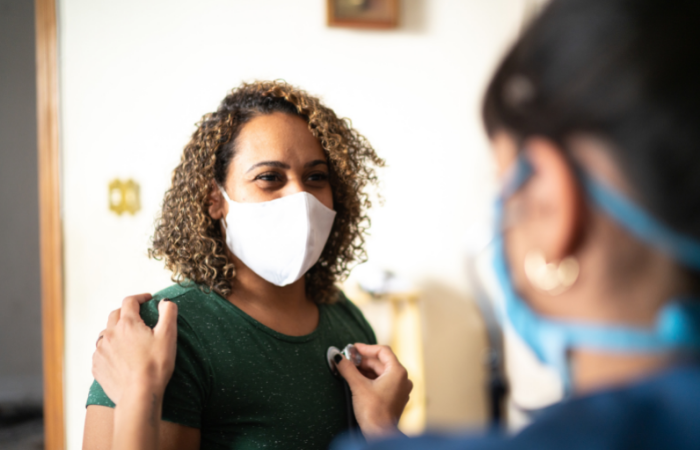What Women Should Know About Lung Cancer

Lung cancer is a leading cause of cancer death among men and women in the United States and is among the most common cancers worldwide. However, there are some important differences in the types, causes, affects, and outcomes of lung cancer for women.
Although lung cancer is not the most common type of cancer among women, it is the leading cause of cancer deaths in women, ahead of breast cancer, uterine cancer, and ovarian cancer combined. Nearly half of new lung cancer diagnoses in the United States are in women.
New Numbers
Research shows that lung cancer diagnoses have increased almost 85% for women over the past four decades, while decreasing about 36% among men during the same time. Lung cancer occurs at a slightly younger age in women than in men, and almost half of lung cancers in young adults occur in women. Researchers have also found that, among people ages 30 to 54, women are more likely than men to develop lung cancer. Currently the risk of developing lung cancer is about 1 in 17 for women.
Almost 20% of women diagnosed with lung cancer today have never smoked (by contrast, only 1 in 12 men with lung cancer have never smoked). Current research does not explain why women are more likely to develop lung cancers that are not caused by smoking. Many medical experts believe the causes may be linked to lifestyle choices, environment, genetics, and hormones.
Women are also more likely than men to have lung cancer cases that can be managed with treatment. While the survival rate for lung cancer in women is higher than for men at all stages of the disease, the overall five-year survival rate is still only 23% for women.
Types of Lung Cancer in Women
There are two main types of lung cancer. Small cell lung cancer (SCLC) occurs in less than 15% percent of patients. It grows quickly and spreads to other organs. Non-Small Cell Lung Cancer (NSCLC) occurs in about 80% of patients. It includes several subtypes of lung cancer, such as squamous cell carcinoma, adenocarcinoma, and large cell carcinoma.
When women develop lung cancer, they’re more likely than men to have adenocarcinoma. In fact, almost half of lung cancer diagnoses in women are adenocarcinoma. On the other hand, men are more likely than women to present with squamous cell lung cancer, the most common type in smokers. One major difference between these lung cancers is that squamous cell cancer, which results in tumors in tissues that line the major airways, causes more symptoms and is easier to diagnose. An early diagnosis can help provide the best outcomes.
Adenocarcinoma in situ (AIS), previously called BAC (bronchioalveolar carcinoma), is a rare form of lung cancer that is more common in women and non-smokers. The survival rate with AIS is better than with other forms of NSCLC, especially when it is caught early.
Hormonal Links
Some cancer research involves the study of estrogen’s influence on tumors. There is evidence that this hormone makes cancer cells grow or makes women more sensitive to elements that can cause cancer. Some studies suggest a link between early menopause (when estrogen levels drop) and a decreased risk of lung cancer. Estrogen-progestin therapy is not linked to a higher risk of getting lung cancer, but it is linked to a higher risk of dying from the disease.
In other research, the use of oral contraceptives was associated with a decreased risk of NSCLC, but similar investigations have not shown the same results. More research is needed to better understand any connection between birth control pills and cancer risks.
Symptoms
Most lung cancers do not cause any symptoms until they spread, but some people with early lung cancer do have symptoms. The most common symptoms of lung cancer are:
- A cough that does not go away or gets worse
- Coughing up blood or rust-colored sputum (spit or phlegm)
- Chest pain that is often worse with deep breathing, coughing, or laughing
- Hoarseness
- Loss of appetite or unexplained weight loss
- Shortness of breath
- Feeling tired or weak
- Infections such as bronchitis and pneumonia that don’t go away or keep coming back
If lung cancer spreads to other parts of the body, it may cause:
- Bone pain in the back or hips
- Nervous system changes (such as headache, weakness or numbness of an arm or leg, dizziness, balance problems, or seizures), from cancer that has spread to the brain
- Yellowing of the skin and eyes (jaundice) from cancer that has spread to the liver
- Swelling of lymph nodes (collection of immune system cells)
If you go to your doctor when you first notice symptoms, your cancer might be diagnosed at an earlier stage, when treatment is more likely to be effective.
Most of these symptoms are usually caused by something other than lung cancer. If you have these symptoms, talk to your doctor right away so the cause can be diagnosed and treated.
The UAB Medicine Lung Cancer Program, a part of the UAB O’Neal Comprehensive Cancer Center, offers patients a multidisciplinary team of physicians and surgeons to evaluate and manage lung cancer. The collaboration of medical and surgical specialists helps ensure the most efficient and effective means of caring for your cancer. Click here to learn more.




